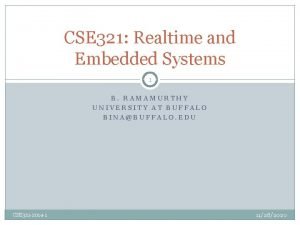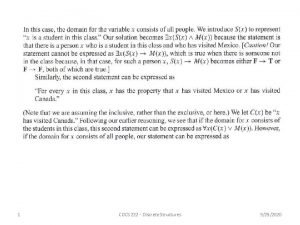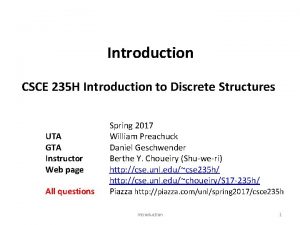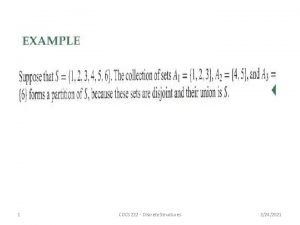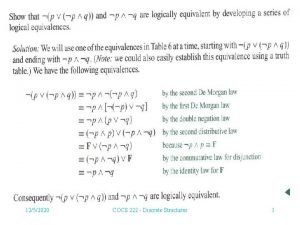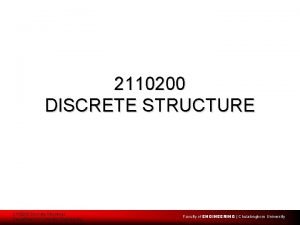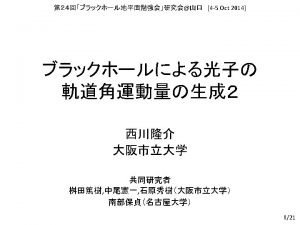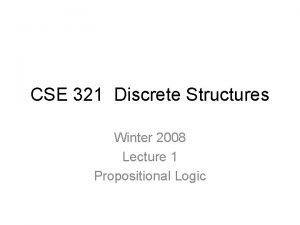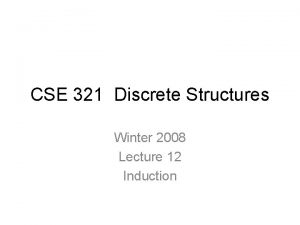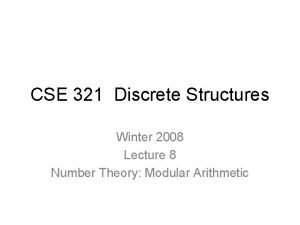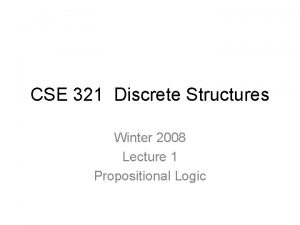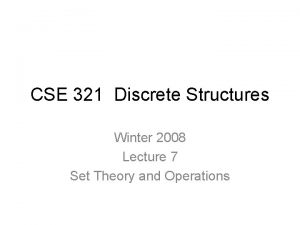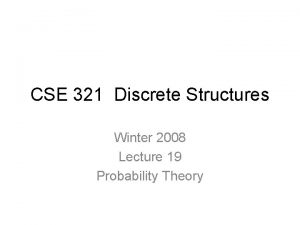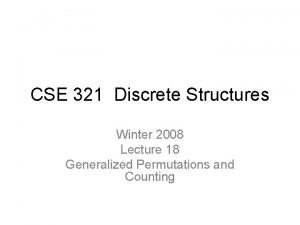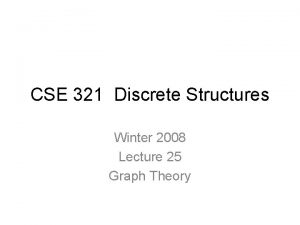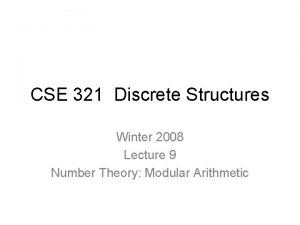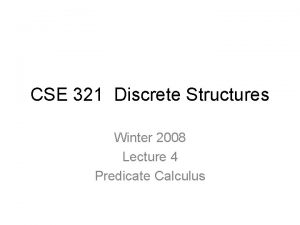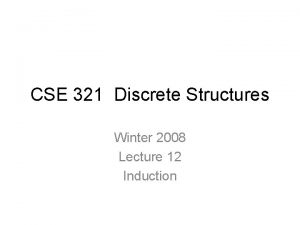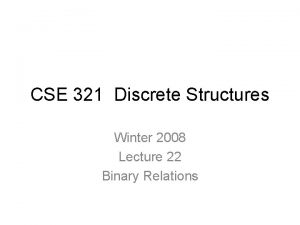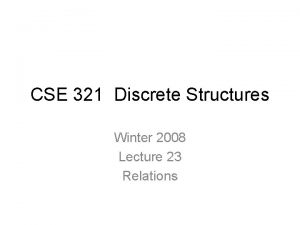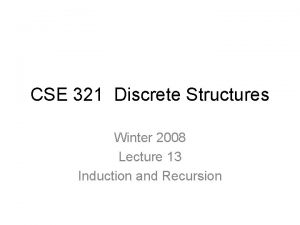CSE 321 Discrete Structures Winter 2008 Lecture 11






![Chinese Remainder Theorem Find an x in [0. . . 11484] such that x Chinese Remainder Theorem Find an x in [0. . . 11484] such that x](https://slidetodoc.com/presentation_image_h2/3e0bd9b428e4716133ca4373154ec551/image-7.jpg)








- Slides: 15

CSE 321 Discrete Structures Winter 2008 Lecture 11 Number Theory: Applications

Announcements • Readings – Friday: • Applications of Number Theory – 3. 7 (5 th Edition: 2. 6) – Next week • Induction and recursion – 4. 1 -4. 2 (5 th Edition: 3. 3 -3. 4) – Midterm: • Friday, February 8

Highlights from Lecture 10 • Primality – Discrete Log Problem – Euclid’s Theorem • Infinitude of Primes – Density of Primes – Factorization vs. Primality Testing – Probabilistic Primality Testing

Greatest Common Divisor • GCD(a, b): Largest integer d such that d|a and d|b • GCD(100, 125) = • GCD(17, 49) = • GCD(11, 66) =

Euclid’s Algorithm • GCD(x, y) = GCD(y, x mod y) int GCD(int a, int b){ /* a >= b, b > 0 */ int tmp; int x = a; int y = b; while (y > 0){ tmp = x % y; x = y; y = tmp; } return x; }

Extended Euclid’s Algorithm • If GCD(x, y) = g, there exist integers s, t, such sx + ty = g; • The values x, y in Euclid’s algorithm are linear sums of a, b. – A little book keeping can be used to keep track of the constants
![Chinese Remainder Theorem Find an x in 0 11484 such that x Chinese Remainder Theorem Find an x in [0. . . 11484] such that x](https://slidetodoc.com/presentation_image_h2/3e0bd9b428e4716133ca4373154ec551/image-7.jpg)
Chinese Remainder Theorem Find an x in [0. . . 11484] such that x mod 11 = 9 x mod 29 = 7 x mod 36 = 14 Simple version: Suppose: p, q prime x a (mod p) x b (mod q) What is x mod pq ?

p, q prime, x mod p = a, x mod q = b • Choose s, t such that sp + tq = 1 • Let f(a, b) = (atq + bsp) mod pq • f(a, b) mod p = a; f(a, b) mod q = b • f is 1 to 1 between [0. . p-1] [0. . q-1] and [0. . pq – 1] • Corollary: – x mod p = a; x mod q = a, then x mod pq = a

Cryptography ALICE BOB

Perfect encryption • Alice and Bob have a shared n-bit secret S • To send an n-bit message M, Alice sends M S to Bob • Bob receives the message N, to decode, Bob computes N S

Public Key Cryptography • How can Alice send a secret message to Bob if Bob cannot send a secret key to Alice? ALICE BOB My public key is: 13890580304018329082310291 80219821092381083012982301 91280921830213983012923813 20498068029809347849394598 17847938828739845792389384 89288237482838299293840200 10924380915809283290823823

RSA • • Rivest – Shamir – Adelman n = pq. p, q are large primes Choose e relatively prime to (p-1)(q-1) Find d, k such that de + k(p-1)(q-1) = 1 by Euclid’s Algorithm • Publish e as the encryption key, d is kept private as the decryption key

Message protocol • Bob – Precompute p, q, n, e, d – Publish e, n • Alice – Read e, n from Bob’s public site – To send message M, compute C = Me mod n – Send C to Bob • Bob – Compute Cd to decode message M

Decryption • • • de = 1 + k(p-1)(q-1) Cd (Me)d= Mde = M 1 + k(p-1)(q-1) (mod n) Cd M (Mp-1)k(q-1) M (mod p) Cd M (Mq-1)k(p-1) M (mod q) Hence Cd M (mod pq)

Practical Cryptography ALICE Here is my public key I want to talk to you, here is my private key BOB Okay, here is my private key ALICE BOB Yadda, yadda BOB
 Cse 321
Cse 321 2008 2008
2008 2008 Winter kommt winter kommt flocken fallen nieder
Winter kommt winter kommt flocken fallen nieder Winter kommt winter kommt flocken fallen nieder
Winter kommt winter kommt flocken fallen nieder Winter kommt winter kommt flocken fallen nieder lied
Winter kommt winter kommt flocken fallen nieder lied 01:640:244 lecture notes - lecture 15: plat, idah, farad
01:640:244 lecture notes - lecture 15: plat, idah, farad Cs 584
Cs 584 Discrete math
Discrete math Discrete structures
Discrete structures Discrete computational structures
Discrete computational structures Discrete structures
Discrete structures Discrete structures
Discrete structures 2110200
2110200 Give other examples of homologous structures
Give other examples of homologous structures Oam 321
Oam 321 Ce 321
Ce 321
